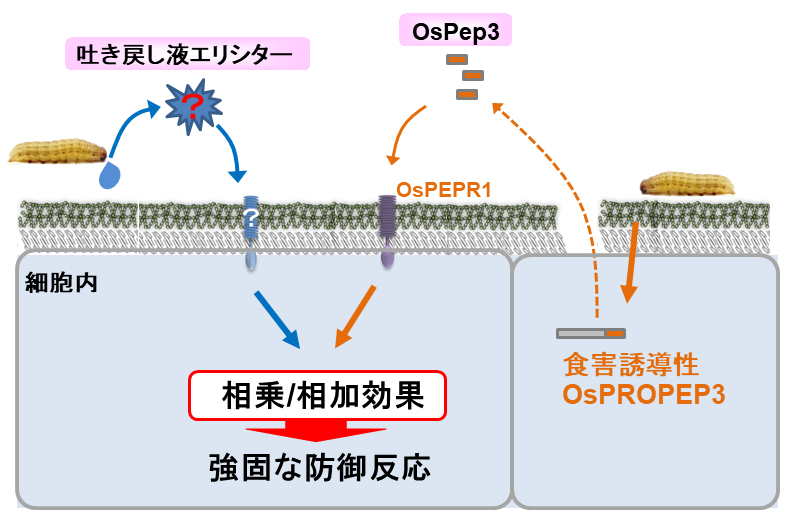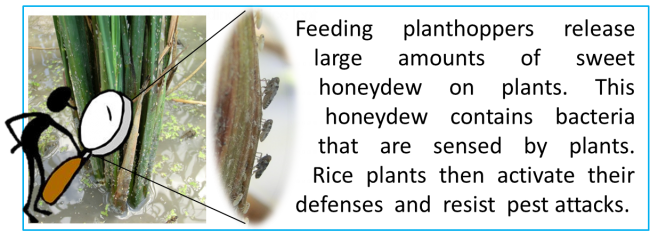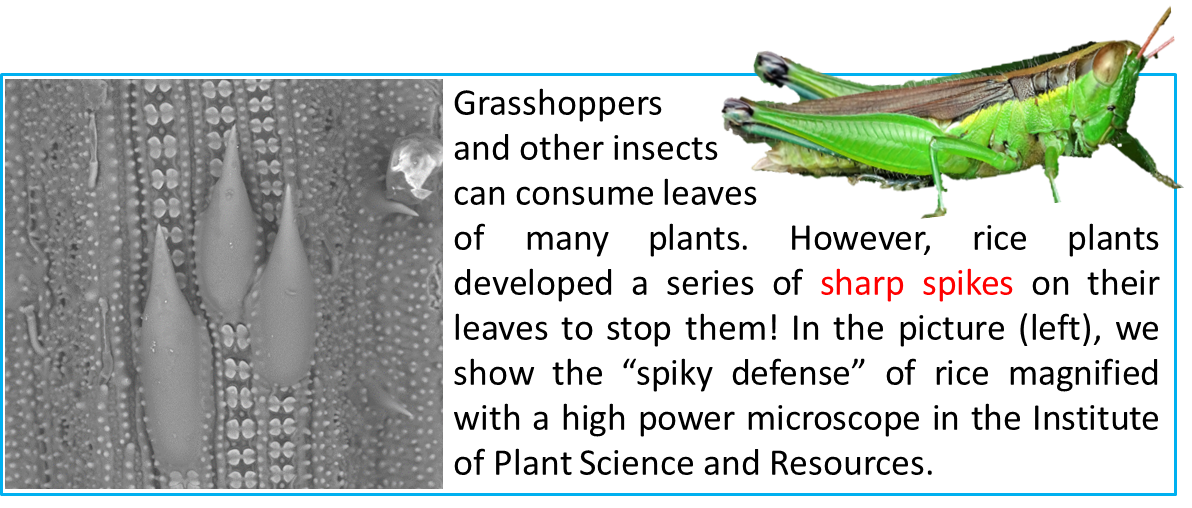1-1:イネを食害する害虫の唾液成分(吐き戻し液)による防御応答の誘導
植物が害虫から食害を受けた際に、植物は害虫を認識して様々な防御応答を誘導します。これまでの研究から植物の害虫認識には、食害時に生じる植物の「傷」と、食害部位で植物細胞と接触する害虫の「唾液成分(吐き戻し液)」が重要な役割を果たすことが知られていました。
今回私たちは、イネを食害する害虫であるクサシロキヨトウとイチモンジセセリを用いて、それぞれの吐き戻し液の成分の解析を行ったところ、2種の害虫の間で、防御応答を誘導する因子の組成に違いがあることがわかりました。また、クサシロキヨトウの吐き戻し液には少なくとも2種類以上の防御誘導因子が含まれており、植物はこれら因子を同時に認識することで、より強い防御応答を誘導することを明らかしました。
植物が害虫に対して防御応答を誘導する際、食害する害虫種により、応答の質(種類)や応答の量(強さ)が異なる場合があることが知られています。植物がどのように害虫種の違いを識別し、どのように防御応答の質・量が決まり適切な防御機構は活性化することができるのか、今後、本研究を発展させることで、詳細な分子メカニズムに迫ることを目指します。

本研究は明治大学、東京大学、The New Zealand Institute for Plant &Food Researchとの共同研究として実施しました。
[掲載論文] Sci. Rep (2016) 6:32537
1-2:食害時のイネ自己損傷に伴い産生する内生ペプチドを介した防御応答の活性化
植物が害虫を認識し防御応答を誘導する上で、食害部位に残存する昆虫の吐き戻し液(唾液)に含まれる分子や、食害により産生する植物分解物を認識することで、強固で効果的な防御応答を誘導します。しかしながら、個々の分子の認識に伴い活性化する防御シグナルがどのように統合され、害虫に対抗する防御反応に至るのかは不明でした。本研究では、イネにおけるクサシロキヨトウ食害認識に関わる植物分解物として、イネの内生ペプチドに注目し、吐き戻し液由来分子との同時認識時の応答を解析しました。その結果、イネが食害を受けた際には害虫由来分子に加え、内生ペプチドを同時に認識することで、より強固な防御応答を誘導することが推察され、防御誘導における興味深いシグナルネットワークの存在が示唆されました。
本研究は奈良先端科学技術大学院大学、国際農林水産業研究センターとの共同研究として実施しました。

[掲載論文] Plant J (2018) 94:626-637
1-3:イネはトビイロウンカの甘露(Honeydew)に含まれる微生物を認識し防御応答を誘導
イネとトビイロウンカの攻防において、ウンカの排出する甘露(Honeydew)中の共生微生物をイネが認識することでウンカ食害を知覚し、防御応答を誘導するという、新規なイネの害虫監視システムを発見しました。この成果はJ Exp Bot・Plant Signal Behavに掲載されました。また、グローバルで平等な科学教育を支援するScience Connectedにおいて紹介されました。
Honeydew-associated microbes elicit defense responses against brown planthopper in rice
Planthoppers are small but serious pests on plants. In rice, brown planthoppers (Nilaparvata lugens) are causing extensive damage by feeding on plants as well as by transmitting viral diseases. It is therefore very important for rice to effectively recognize the pest and activate its strong defense responses soon after attack. Here we found that honeydew which is released from feeding planthoppers contains various bacterial cells that are rapidly detected by rice plants. We propose that microbes in planthopper sweet secretions betray the pest to rice plants and thus serve as important signals (elicitors) of rice defense. We speculate that this may be a general system in plants to activate their defenses against various sucking pests which are all commonly producing honeydew during feeding.

掲載論文:J Exp Bot (2019) 70: 1683-1696, Plant Signal Behav (2019) 14: 1655335
Science Connectedによる紹介:Science Connected magazine
研究概要:農作物自身の防御機構の最前線で働く「害虫監視システム」が、害虫の目印として標的にする因子を複数発見しました。本研究で、ウンカ、ハダニ、ヨトウムシ食害に関わる因子を同定しており、食害を受けた作物は、監視標的因子を認識することで耐虫性を上昇させます。農作物の害虫被害が世界的に問題になってるなか、本研究成果から、耐虫性作物の開発や、作物の防御機構を活性化する植物活性化剤の開発への展開が期待されます。
背景・成果・展望:作物の害虫監視システムが標的としている因子を複数発見しました。これらは害虫由来、または食害時に産生する植物由来因子で、作物がこれら因子を認識することで耐虫性機構が活性化されることを明らかにしました。これらの成果は植物科学分野で評価されている専門誌であるJ Exp Bot誌、New Phytol誌、Plant J誌に2018年度に掲載されました。
作物の害虫監視システムが標的とする因子の報告が限られていたなかで、複数の因子の同定した本研究成果は、植物免疫機構や、植物の自己-非自己認識機構を理解する上で学術的に大きな意義があります。また、本研究成果を用いた耐虫性作物の開発や、作物の耐虫性機構活性化剤など、低環境負荷な害虫防除法への応用が考えられ、持続可能な農業への貢献が期待されます。

[掲載論文] Plant J (2018) 94: 626-637, J Exp Bot (2019) 70: 1683-1696, New Phytol (2019) 224: 875-885
ハダニテトラニンの研究(New Phytol 2019)は東京理科大学有村研究室が中心となって行われ、共同研究として参加しています。
イネにおいて植食性昆虫による食害時に蓄積するイネの二次代謝物の網羅的解析を行いました。その中で見出したフェノールアミドは、複数の植食性昆虫(シロナヨトウ、イチモンジセセリ、トビイロウンカ)により顕著に誘導されることを見出しました。また、フェノールアミドはトビイロウンカに毒性を示すことを明らかにしました。フェノールアミドはイネの耐虫性に関与する新しいグループの二次代謝物であることが示唆されました。
Rice plants defend from herbivores by production of phenolamide phytoalexins
Most plants respond to herbivore attack and wounding by production of protective defense metabolites (phytoalexins). We analyzed response of rice plants to two types of herbivores, chewing (lawn armyworm Spodoptera mauritia, rice skipper Parnara guttata) and sucking (brown planthopper Nilaparvata lugens) insects. Both attackers induced strong accumulation of phenolamide phytoalexins in the leaves. In addition, these phenolamides were directly toxic to brown planthoppers when added to artificial diet used for rearing of these insects in the laboratory. Our work proposed a new group of defense compounds in rice that is highly effective against various types of insects. It also provided a potentially new tool for the improvement of herbivore-susceptible rice cultivars by genetically increasing their endogenous phenolamide levels during critical stages of development.

In collaboration with the Max Planck Institute for Chemical Ecology, Jena, Germany
[掲載論文] Plant Cell Environ (2016) 39: 453-466
植物は害虫食害時に揮発性物質を放出することで、害虫に対する天敵昆虫を誘引し、害虫を退治してもらうという間接防御と呼ばれる防御機構が知られています。本研究ではイネの放出する揮発性物質を回収する実験系を構築し、2種の植食性昆虫(広食性および狭食性昆虫)を用いて食害時の揮発性物質放出を調べました。その結果興味深いことに、用いた2種の植食性昆虫の食害により放出される揮発性物質に量的な違いがあることがわかりました。もしかしたら植物は植食性昆虫種を見分けて、昆虫種に応じた防御応答をしているのかもしれません。あるいは、植食性昆虫側が何らかの方法で植物の揮発性物質の放出を抑えているのかもしれません。
Rice plants are calling for help using volatile compounds
Most plants respond to herbivore attack and wounding by production of volatile organic compounds that attracts natural enemies of herbivores. We show that rice plants not only release a whole blend of volatiles after herbivore attack but they also release different amounts of these volatiles when specialist and generalist herbivores attack them. Therefore, rice plants can “recognize” their herbivores based on the signals (elicitors) contained in the insect oral secretions. We propose that rice emits specific signals to attract specialized parasitoid wasps and/or predators for each herbivore, which can greatly increase the efficiency of indirect defense responses in rice.

[掲載論文] JOURNAL OF CHEMICAL ECOLOGY (2017) 43: 929-943
研究概要:イネの葉表層の微細な針状突起が、バッタなどの害虫による食害を抑える防御戦略に利用されていることを発見しました。一方で、アフリカで普及が進んでいるネリカのように、針状突起を有していない品種が存在することも明らかになりました。農作物の害虫被害が喫緊の世界的課題となるなか、本成果を元にした作物の耐虫性向上戦略など、持続可能な農作物増産への貢献が期待されます。
背景・展望:アジアイネの葉表層の微細で堅い針状突起(ケイ化トライコーム)がバッタなどの害虫による食害を抑えることを発見しました。一方で、アフリカで食糧事情の改善に向けて開発・普及が進んでいるネリカ(NERICA)は突起構造を有していませんでした。この成果は植物環境応答分野で評価されている専門誌であるPlant Cell Environ誌に2020年に掲載されました。
近年の気候変動やグローバルな人・物移動に伴う病虫害の拡散や農作物被害の増加がみられるなか、本成果を元にした耐虫性作物の開発や、低環境負荷な害虫防除法への応用が考えられ、持続可能な農業への貢献が期待されます。また、作物の新規な防御システムを発見した本研究成果は、植物の病虫害耐性メカニズムを理解する上で学術的に意義があります。
掲載論文:Plant Cell Environ (2020) 43: 2019-2032
同号に掲載されたKaur博士、 Kariyat博士によるコメンタリーで本研究が紹介されました:Plant Cell Environ (2020) 43: 2015-2018

Sharp spikes on their leaves help rice plants to fight against grasshoppers and other insects
Because of easy cooking, good taste and possibility of long storage, rice became popular food source in many African households. Therefore, NERICA rice, which actually means “New Rice for Africa”, was developed with a strong aim for further promotion and wider spread of rice production in Africa. NERICA varieties were obtained by genetic cross between two rice species, one from Asia and one from Africa, in order to combine a high productivity of an Asian parent, and an adaptation to local conditions of an African parent. Although NERICA varieties show good productivity and satisfactory growth in Sub-Saharan Africa, they have not been extensively tested for their resistance against herbivores. When we planted NERICA 1, 4 and 10 in the paddy field in Japan, we immediately noticed that compared to local Japanese rice varieties, all NERICAs were much more damaged by grasshoppers and other pests. By close comparison with Nipponbare, one of the strong local cultivars, we found that NERICAs completely lack series of abundant spiky trichomes on the surface of their leaves. In our report in Plant Cell & Environment, we show a strong evidence that these spiky structures are actually very important for efficient defense of rice plants against grasshoppers and other abundant herbivores in the field. We also show that the spikes (trichomes) on rice surface must be impregnated with silicon (a mineral obtained by plants from soil) to gain sufficient mechanical strength, and thus ability to rescue rice plants from extensive damage by outnumbering herbivores in the field.

Published in Plant Cell Environ (2020) 43: 2019-2032
3-3:食害と日夜にともなうイネの揮発性物質産生の制御とオキシリピンの役割
研究概要:イネにおいて、1日の中で揮発性物質の放出パターンがどのように変化するか、またそれらが食害によりどのように変化するのかを解析しました。さらに、揮発性物質の放出制御におけるジャスモン酸をはじめとするオキシリピンの役割について解析し議論しています。
掲載論文:Mujiono et al. Plant Cell & Envrion (2021) 44, 2687-2699
Herbivore-induced and constitutive volatiles are controlled by different oxylipin-dependent mechanisms in rice
Plants attacked by insect herbivores emit blends of volatile organic compounds to attract natural enemies of herbivores that are then used as plant’s bodyguards. In this work, we monitored herbivore-elicited volatiles in rice and found that several compounds, such as linalool, can be easily induced by herbivory stress. On the other hand, rice is also producing an array of other volatiles, many of which are released during day and suppressed at night (show diurnal emission pattern). We report that while herbivore-induced plant volatiles are triggered by plant hormone jasmonic acid, diurnal volatiles including caryophyllene in rice do not respond to jasmonate burst that is immediately triggered inside of rice by insect attack. Instead, diurnal volatiles followed the accumulation of 12-oxo-phytodienoic acid (OPDA), which is a well-known jasmonic acid precursor in the same oxylipin pathway. We therefore conclude that while both types of volatiles in rice depend on the oxylipin pathway, actual regulators for stress induced and diurnal volatiles may differ, and therefore these volatiles can show specific emission patterns from plants.
3-4:イネのファイトアレキシン産生におけるJA前駆体OPDAの役割の解析
イネは病虫害に対する応答として、多様な二次代謝物を蓄積し病原菌の感染や虫害の拡大を防いでいます。イネの防御関連二次代謝物の一種であるフェノールアミドは、病原菌感染や害虫寄生、傷害に応答して産生されます。今回、代表的な真菌エリシターであるキチンオリゴ糖を用いて、イネのフェノールアミドの産生制御機構の解析を行いました。イネ培養細胞を用いたモデル実験系において、キチンエリシター処理によりフェノールアミド蓄積が誘導されるとともに、ジャスモン酸を含むオキシリピンの蓄積誘導が見られ、これらがフェノールアミド産生制御因子の候補と考えられました。しかし、防御反応誘導能が知られているジャスモン酸やジャスモン酸イソロイシンを培養細胞に処理したところ、フェノールアミド誘導が認められませんでした。一方で、ジャスモン酸前駆体であるOPDAはフェノールアミドを誘導しました。さらに遺伝学的解析により、OPDAアミノ酸複合体化がイネ細胞内のOPDAの生物活性に必要であることが示唆されました。そこで2種のOPDAアミノ酸複合体を合成したのですが、防御応答誘導活性は認められず、今後の課題となりました。しかしながら本研究により、イネにおいてOPDAシグナルがOPDA以外のエリシター誘導性シグナルと相互作用して防御関連二次代謝物を制御するという役割を提示できました。
本研究は帝京大学、東京大学との共同研究として実施しました。
[掲載論文] Shinya et al. Plant Mol Biol. in press
